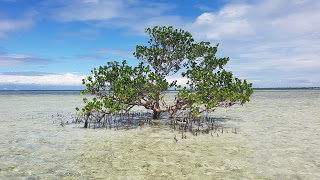10 Sustainable Travel Tips to Reduce
Your Environmental Impact
Monday, January 20th, was apparently the “most depressing day of the year”, suggesting that many of us tend to be under the weather due to the cold, lack of sunlight and pending bills from our Christmas expenses.
On the other hand, some of us may just be affected by the seasonal blues as a result of winter’s cold weather and darker days. I sometimes dream of going traveling to get away from it all and start imagining the places I can escape to with warm weather and nice beaches. If you’re like me, you’re ready to go on your next holiday by now.

Beach in Koh Lipe, Thailand
I’ve compiled some tips on how to travel more sustainably based on my own travel experiences and lessons learned, so you can enjoy your trip without worrying about your impact on the environment.
1. Fly less, choose direct
Depending on where you plan to go, not flying is the best way to reduce your carbon emissions. I suggest seeing if there is an alternative mode of transportation with a lower carbon footprint. For instance, if you’re looking for a change of scenery, consider a road trip to a picturesque cabin in the woods that is accessible by car (or bus, or train) within a 2-3 hour drive, ideally if you’re carpooling.
However, if you’re trying to flee the winter, you’ll probably have to go a bit further and will likely need to get there by plane. If that’s the case, consider purchasing carbon offsets that invest in projects such as tree planting or capturing methane gas from landfills. Since planes burn the most fuel at takeoff, direct flights are more carbon efficient.
2. Carbon offsets
Purchasing carbon offsets when you fly allows you to contribute to projects that help combat climate change and reduce carbon emissions, including protecting forests and biodiversity, providing renewable energy and clean drinking water. While carbon offsets are a great option to “counteract” your carbon emissions caused by flying, choosing not to fly or to fly less is the most sustainable choice.
3. Pack lightly
If you’re going away for 1 week – 10 days, you may consider bringing only enough clothes to fit into your carry on baggage. Not only could you save money, you’ll also save time. Some airlines are now charging additional fees for check-in luggage and the excess luggage weight increases the flight’s carbon emissions. Plus, you’ll be one of the first to get out of the airport and to your final destination. #winning
Check the weather for your destination and pack accordingly: a few basics/staples such as a pair of pants, shorts, skirt and dress mixed with a couple of shirts and a sweater go a long way. Don’t worry about re-wearing some of the same outfits – the chances of you ever seeing the same people again are slim.
4. Bring your own toiletries in reusable bottles/containers
Most hotels offer complimentary toiletries as part of room service. Whatever isn’t used or is only partially so is then thrown out, sending a substantial amount of plastic to the landfill. Since many of us already have our own beauty routine, what better way to stick to it than to bring our own products to use?
5. Bring reusable cutlery (preferably bamboo)
When I traveled for 8 months last year, I carried reusable cutlery with me. I had both a plastic and a stainless steel set but the latter got confiscated going through security at the airport because I’d forgotten it in my carry on bag…rookie mistake. Bamboo cutlery isn’t sharp enough to be considered a weapon, which makes it an ideal option.
6. Bring your own containers/bags for eating out/snacks
This is a tip I wish I’d put into practice myself while I was traveling in Asia. There were so many markets I went to where they served the food to us on styrofoam plates or in plastic bags, which could have been placed into my own container if I’d thought to bring them at the time. #travelgoals
7. Bring a reusable cup and stainless steel/bamboo straws,
if needed
Oftentimes when we order a drink from our waiter at a restaurant or bar, it automatically comes to us with a plastic straw, even if we didn’t want or need it.
In fact, Canadians use close to 57 million straws per day, many of which end up in landfills and, eventually, in the ocean. 
Enjoying Thai milk tea in Phuket
8. Bring (a) reusable bag(s)
Whether you’re out shopping for souvenirs or ingredients for your next meal, or carrying your water shoes after a day of rafting on the river, having your own bag will always come in handy.
9. Skip the cruise
Although cruises in the Caribbean or Mediterranean are popular vacation choices, they are also known for having similar carbon emissions to flying. Most cruise companies have no waste management system on board and dump garbage directly into the ocean. Yuck. Plus, you don’t get much time to visit the places because you have to follow their tight schedule. I don’t know about you but being stranded on a boat with thousands of other people is not my idea of a good time.
10. Choose your destination intentionally
Whether you want to help a local economy to rebuild after being hit by a hurricane (only when it is safe to do so), or to volunteer at an animal sanctuary, it’s best to prioritize places whose community will benefit most from your visit.
Sustainability highlights the importance of protecting our environment, but it also has a strong social component. The money from tourism received by the countries we visit can be used for capacity building, climate change adaptation/mitigation and other sustainability projects to ensure a healthy and sustainable future for themselves.
Safe travels / Bon voyage!

Hiking through Mer Bleue Bog
For more information on carbon offsets:
– Carbon Footprint Calculator
https://www.carbonfootprint.com/calculator.aspx
– Sustainable Travel International – Calculate your carbon footprint
https://sustainabletravel.org/our-work/carbon-offsets/calculate-footprint/
– Mindful Flights – https://www.mindfulflights.com/en/offset/
– A complete guide to carbon offsetting
https://www.theguardian.com/environment/2011/sep/16/carbon-offset-projects-carbon-emissions
Additional resources:
– Be a more sustainable traveler
https://www.nytimes.com/guides/travel/how-to-travel-sustainably?fbclid=IwAR0k9XFAvnXZ0phJ8Z8XwEX370lmKsT5rmdtpSxFZaSE5yZyYFqb-9KhVhM
– Climate change: Should you fly, drive or take the train?
https://www.bbc.com/news/science-environment-49349566


